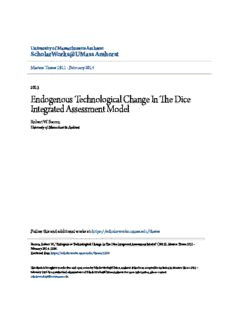Table Of ContentUUnniivveerrssiittyy ooff MMaassssaacchhuusseettttss AAmmhheerrsstt
SScchhoollaarrWWoorrkkss@@UUMMaassss AAmmhheerrsstt
Masters Theses 1911 - February 2014
2013
EEnnddooggeennoouuss TTeecchhnnoollooggiiccaall CChhaannggee IInn TThhee DDiiccee IInntteeggrraatteedd
AAsssseessssmmeenntt MMooddeell
Robert W. Barron
University of Massachusetts Amherst
Follow this and additional works at: https://scholarworks.umass.edu/theses
Barron, Robert W., "Endogenous Technological Change In The Dice Integrated Assessment Model" (2013).
Masters Theses 1911 - February 2014. 1106.
Retrieved from https://scholarworks.umass.edu/theses/1106
This thesis is brought to you for free and open access by ScholarWorks@UMass Amherst. It has been accepted for
inclusion in Masters Theses 1911 - February 2014 by an authorized administrator of ScholarWorks@UMass
Amherst. For more information, please contact [email protected].
Endogenous Technological Change In The DICE Integrated Assessment Model
A Thesis Presented
by
ROBERT BARRON
Submitted to the Graduate School of the
University of Massachusetts Amherst in partial fulfillment
of the requirements for the degree of
MASTER OF SCIENCE IN INDUSTRIAL ENGINEERING AND OPERATIONS
RESEARCH
September 2013
Mechanical and Industrial Engineering
i
© Copyright 2013 by Robert Barron
All Rights Reserved
ii
Endogenous Technological Change In The DICE Integrated Assessment Model
A Thesis Presented
by
ROBERT BARRON
Approved as to style and content by:
____________________________________
Erin D. Baker, Chair
_________________________________
Hari Balasubramanian, Member
___________________________________
John Stranlund, Member
_______________________________
Donald L. Fisher, Department Head
Mechanical and Industrial Engineering
iii
DEDICATION
To Bill W.
iv
ACKNOWLEDGMENTS
I would like to thank my advisor, Professor Erin Baker for her support and guidance.
I also owe a debt of gratitude to my committee members, Professors Hari
Balasubramanian and John Stranlund, for their feedback and advice, and to my
undergraduate advisor, Professor Donald Fisher for his guidance and support, without
which I might have followed a different path.
I would also like to extend my thanks to my colleague Rose Zdybel, for her key
assistance in generating pivot and shift factors for my model, and to the National Science
Foundation for their financial support.
Finally, I am grateful to my colleagues and friends who have lightened my mood and
buoyed my spirits during this process.
v
ABSTRACT
ENDOGENOUS TECHNOLOGICAL CHANGE IN THE DICE INTEGRATED
ASSESSMENT MODEL
SEPTEMBER 2013
ROBERT BARRON, B.S., UNIVERSITY OF MASSACHUSETTS AMHERST
M.S.I.E.O.R., UNIVERSITY OF MASSACHUSETTS AMHERST
Directed by: Professor Erin Baker
Integrated Assessment Models (IAM)s play a key role in climate policy research;
however, many IAMs are limited by their treatment of technological change. This is a
particularly vexing limitation because technological change significantly affects the
optimal carbon policy. We propose a means of incorporating technological change within
the Dynamic Integrated Model of the Climate and Economy (DICE). We modify DICE to
allow it to adjust the cost of CO2 abatement based on the demand for solar photovoltaic
generating capacity.
We find that deployment of solar photovoltaics (PV) is highly sensitive to returns to
scale and the grid integration costs associated with PV intermittency. At low returns to
scale integration costs cause PV to be deployed in steps, reducing the benefit of scale
effects; at higher returns to scale PV is deployed smoothly but is arrested integration
costs become significant; and when returns are high PV becomes so inexpensive that it’s
deployed widely in spite of integration costs. The implication of this behavior is that the
optimal allocation of research and development resources depends on returns to scale in
the solar market: if returns to scale are low, R&D should focus on PV itself, while if
they’re high, R&D should focus on reducing integration costs.
vi
TABLE OF CONTENTS
Page
ACKNOWLEDGMENTS .................................................................................................. v
ABSTRACT ....................................................................................................................... vi
TABLE OF CONTENTS .................................................................................................. vii
LIST OF TABLES ............................................................................................................. ix
LIST OF FIGURES ............................................................................................................ x
CHAPTER
1. INTRODUCTION .......................................................................................................... 1
1.1 Motivation ..................................................................................................... 1
1.2 Objectives ..................................................................................................... 1
1.3 Contributions................................................................................................. 2
2. BACKGROUND ............................................................................................................ 3
2.1 Climate Change From an Economic Perspective .......................................... 3
2.1.1 Climate Change as a Market Failure ......................................................... 4
2.1.2 The Role of Climate Change Policy .......................................................... 4
2.2 Technological Change .................................................................................. 5
2.2.1 Learning by Doing .................................................................................... 5
2.2.2 Returns to Scale ......................................................................................... 6
2.2.3 Induced Technological Change ................................................................. 6
2.3 Abatement ..................................................................................................... 7
2.3.1 The Total Abatement Cost Curve.............................................................. 7
2.3.2 The Marginal Abatement Cost Curve ....................................................... 8
2.4 Integrated Assessment Models ................................................................... 11
2.4.1 Endogenous Technological Change in IAMs.......................................... 12
2.4.2 The DICE Model ..................................................................................... 13
2.4.3 The Global Change Assessment Model (GCAM) .................................. 15
3. THE DICE-S MODEL .................................................................................................. 16
3.1 Overview ..................................................................................................... 16
3.2 Sizing the Market ........................................................................................ 16
3.3 Apportioning the Market............................................................................. 17
vii
3.4 Solar Price ................................................................................................... 18
3.4.1 Technology Cost ..................................................................................... 19
3.4.2 Integration Cost ....................................................................................... 19
3.5 Changing the TAC curve ............................................................................ 21
3.6 Model Calibration ....................................................................................... 22
3.6.1 Energy Intensity of the Economy ( ...................................................... 22
3.6.2 Backup Price ........................................................................................... 24
3.6.3 The Logit Choice Equation ............𝝉..)....................................................... 25
3.6.4 The Pivot and Shift Parameters. .............................................................. 26
3.6.5 Technology Price Estimates .................................................................... 27
3.6.6 Scale Parameters ..................................................................................... 29
3.7 Solver Configuration ................................................................................... 30
4. RESULTS ..................................................................................................................... 32
4.1 Overview ..................................................................................................... 32
4.2 The Solar Market ........................................................................................ 32
4.3 Abatement ................................................................................................... 37
4.4 Environment ................................................................................................ 39
4.5 Welfare ........................................................................................................ 41
4.6 Conclusions ................................................................................................. 41
4.7 Future Work ................................................................................................ 42
APPENDIX: MODEL CODE .......................................................................................... 43
BIBLIOGRAPHY ............................................................................................................. 77
viii
LIST OF TABLES
Table Page
1. Energy intensity of the economy in GCAM. ................................................................ 23
2. Backup electricity in GCAM. ....................................................................................... 24
3. Initial price of backup electricity. ................................................................................. 25
4. Pivot and shift estimates from GCAM. ........................................................................ 26
5. Levelized Electricity costs in $/GWh used for price path. . ......................................... 28
6. Electric generation (GWh) in 2009. .............................................................................. 29
7. Technology cost values ($/GWh). . .............................................................................. 29
8. Summary of stability constraints. . ............................................................................... 31
9. Effect of RTS Factor on Welfare. ................................................................................. 41
ix
Description:Endogenous Technological Change In The Dice. Integrated Assessment Model. Robert W. Barron. University of Massachusetts Amherst. Follow this and additional works at: https://scholarworks.umass.edu/theses. This thesis is brought to you for free and open access by ScholarWorks@UMass Amherst.

